FIELD TRIP I: ART & MIN(D)ING
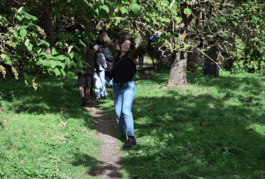
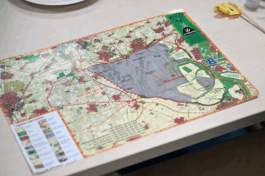
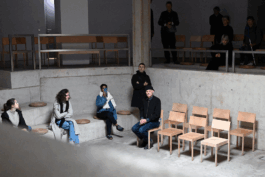
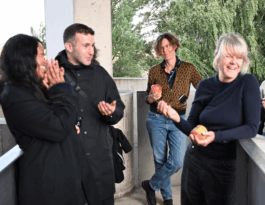
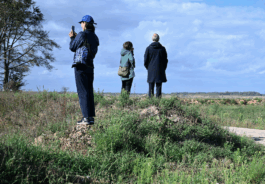
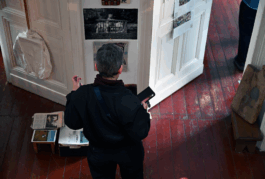
pictures above © Jan Lemitz
Date
September 16th/17th
Raketenstation Hombroich,
Tagebau Hambach, Manheim,
Hochneukirch-Jüchen,
Kreyenburg, Kuckum
Our first field trip took us deep into the layered histories and shifting landscapes of the Rhenish lignite mining region – a place where art, activism, and industrial transformation are tightly interwoven.
We kicked off the two-day journey at the Raketenstation Hombroich, where Cold War missile silos have long given way to minimalist architecture, open skies, and contemporary art. Guided by a knowledgeable host, the participating artists and curators of the group learned more about this historic location, even getting a glimpse into Raimund Abraham's House for Musicians and the Siza Pavilion by Álvaro Sina and Rudolf Finsterwalder.
It's a site where military past and artistic present quietly coexist – a fitting place to begin exploring tensions between destruction and creation, past and future.
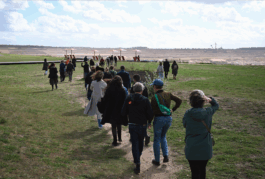
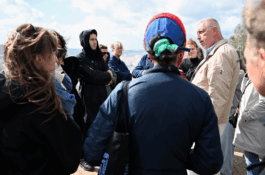
Originally, the afternoon was set to include a descent into the Garzweiler open-cast mine. However, due to heavy rainfall, we had to pivot and headed instead to the Terra Nova viewpoint at the Hambach mine, guided by a representative from RWE. From this vantage point, we looked out over a surreal, almost lunar landscape: vast, empty, and unsettlingly quiet. Our guide offered insights into the scale of extraction, the engineering behind it and the unique properties of the material. He outlined corporate perspectives on resettlement and renaturation projects, that had been carried out since the beginning of opencast mining.
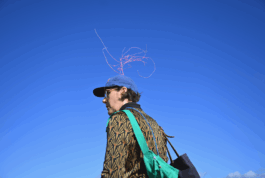
Afterwards we visited Manheim, a district in Rhein-Erft west of Cologne, currently undergoing partial demolition and resettlement due to lignite mining. Our guide, Silke Schatz, shared insights into Manheim’s present and the role of activists and local communities in shaping its future. She also showed us the activist camp’s gathering point, offering a window into the daily life and aims of local actors on the ground. We then walked to the forest’s edge ("Sündenwäldchen"), continuing our discussion in a setting that highlighted the spatial and emotional dimensions of the site. This provided a firsthand view of how such areas are evolving amid energy extraction and structural change, offering a more personal, on-the-ground perspective — highlighting the environmental and social impacts of mining, beyond the official narrative.
Back at Hombroich, the day ended with a shared dinner and stories from Inge Broska, artist and lifelong resident of the region. Her reflections brought a human dimension to the broader themes we had been exploring. Together with Broska, we watched SLOW VIOLENCE by Studio Lemercier. The film opens with playful forest imagery and then depicts the destruction of landmarks and nature through increasingly stark sequences, including aerial views of both the open-cast mine work and the active resistance.
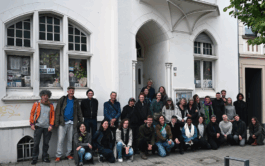
Day two began at Broska’s “Hausmuseum,” a deeply personal archive of life in the mining zone and a site of resistance and memory. After Inge Broskas home in Otzenrath was excavated, she relocated to Jüchen-Hochneukirch and began collecting relics from destroyed localities, turning her house into a museum. There, found objects are categorised and presented together with evidence of her own lifelong artistic practice in a unique way, according to her own system. We explored the space individually to form personal impressions, discovering different artefacts we later discussed; the Hausmuseum serves primarily to give visibility to what would otherwise be lost — the regional resistance and the numerous personal fates tied to the mining industry and transgenerational exchange that seeks to ensure that these fates are not forgotten.
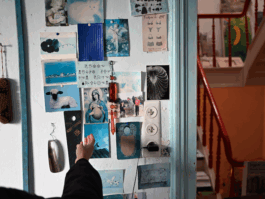
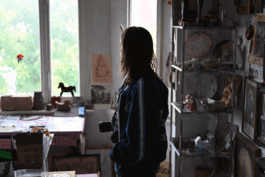

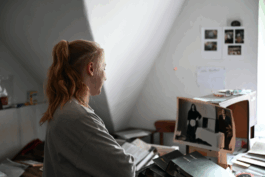
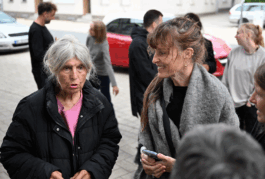
pictures above © Jan Lemitz
From there, we made our way to Keyenberg, A village right on the border of the open-cast mine, that was nearly demolished in order to extract the lignite that lies beneath the buildings, some of which are centuries old. Since demolition had been hanging over the town like the sword of Damocles for decades, renovation work was often not carried out. Gradually, residents sold their houses and land. Cemetery graves were relocated and the church was deconsecrated. Over 80% had sold their houses when the decision was made not to demolish the village after all. Walking through the village, you feel like you're in a ghost town. However, notices on windows and information boards make it clear that “this place is inhabited. Please be considerate of the residents.”
We were welcomed by representatives of the Landfolge Garzweiler special-purpose association, who presented their plans for the Kreyenberg art colony to us on site. This is a location in a former square farmstead that is to be extensively renovated and will in future serve as a cultural center for the village, offering artist residencies, exhibitions, and other conceivable formats. It is a place that shows that life goes on here. Kreyenberg thus symbolizes the dilemma facing the region, but also the new opportunities arising from the upheaval. Volker Mielchen explained the current situation in the region, highlighting the opportunities available and the direction in which things are heading. Antje Grothus, Environmentalist, politician, member of the North Rhine-Westphalia state parliament, and former member of the Coal Commission, then presented her work and view of the situation on site. Grothus spoke about decades of local resistance in the lignite region, which had grown demotivated. She highlighted how mostly young activists renewed hope, mobilized residents, and helped halt the mining. This inspiring story sparked discussions within the group about how to raise the profile of these activist struggles and how to involve previously neglected groups into the new resettlement plans.
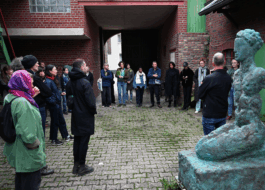
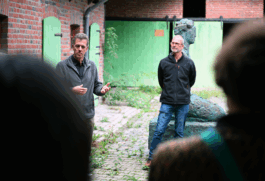
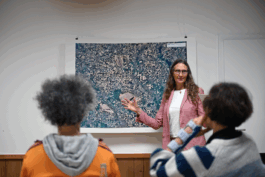
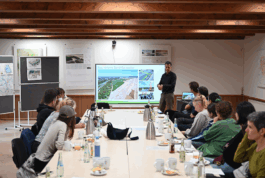

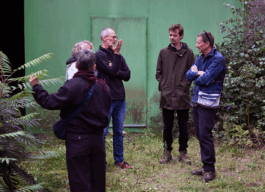
The two-day field trip vividly illustrated how deeply the Borderland EuRegion has been shaped by coal mining. For centuries, it not only sculpted the region’s appearance but also the lives of thousands tied to the industry. Even when traces fade in some places, they endure—especially where art and artistic practice open new perspectives and illuminate the processes at work. At the same time, we learned that the voices of local people must stay central: their experiences, memories, and viewpoints should be foregrounded and clearly heard.
FIELD TRIP I: ART & MIN(D)ING






pictures above © Jan Lemitz
Date
September 16th/17th
Raketenstation Hombroich,
Tagebau Hambach, Manheim,
Hochneukirch-Jüchen,
Kreyenburg, Kuckum
Our first field trip took us deep into the layered histories and shifting landscapes of the Rhenish lignite mining region – a place where art, activism, and industrial transformation are tightly interwoven.
We kicked off the two-day journey at the Raketenstation Hombroich, where Cold War missile silos have long given way to minimalist architecture, open skies, and contemporary art. Guided by a knowledgeable host, the participating artists and curators of the group learned more about this historic location, even getting a glimpse into Raimund Abraham's House for Musicians and the Siza Pavilion by Álvaro Sina and Rudolf Finsterwalder.
It's a site where military past and artistic present quietly coexist – a fitting place to begin exploring tensions between destruction and creation, past and future.


Originally, the afternoon was set to include a descent into the Garzweiler open-cast mine. However, due to heavy rainfall, we had to pivot and headed instead to the Terra Nova viewpoint at the Hambach mine, guided by a representative from RWE. From this vantage point, we looked out over a surreal, almost lunar landscape: vast, empty, and unsettlingly quiet. Our guide offered insights into the scale of extraction, the engineering behind it and the unique properties of the material. He outlined corporate perspectives on resettlement and renaturation projects, that had been carried out since the beginning of opencast mining.

Afterwards we visited Manheim, a district in Rhein-Erft west of Cologne, currently undergoing partial demolition and resettlement due to lignite mining. Our guide, Silke Schatz, shared insights into Manheim’s present and the role of activists and local communities in shaping its future. She also showed us the activist camp’s gathering point, offering a window into the daily life and aims of local actors on the ground. We then walked to the forest’s edge ("Sündenwäldchen"), continuing our discussion in a setting that highlighted the spatial and emotional dimensions of the site. This provided a firsthand view of how such areas are evolving amid energy extraction and structural change, offering a more personal, on-the-ground perspective — highlighting the environmental and social impacts of mining, beyond the official narrative.
Back at Hombroich, the day ended with a shared dinner and stories from Inge Broska, artist and lifelong resident of the region. Her reflections brought a human dimension to the broader themes we had been exploring. Together with Broska, we watched SLOW VIOLENCE by Studio Lemercier. The film opens with playful forest imagery and then depicts the destruction of landmarks and nature through increasingly stark sequences, including aerial views of both the open-cast mine work and the active resistance.

Day two began at Broska’s “Hausmuseum,” a deeply personal archive of life in the mining zone and a site of resistance and memory. After Inge Broskas home in Otzenrath was excavated, she relocated to Jüchen-Hochneukirch and began collecting relics from destroyed localities, turning her house into a museum. There, found objects are categorised and presented together with evidence of her own lifelong artistic practice in a unique way, according to her own system. We explored the space individually to form personal impressions, discovering different artefacts we later discussed; the Hausmuseum serves primarily to give visibility to what would otherwise be lost — the regional resistance and the numerous personal fates tied to the mining industry and transgenerational exchange that seeks to ensure that these fates are not forgotten.





pictures above © Jan Lemitz
From there, we made our way to Keyenberg, A village right on the border of the open-cast mine, that was nearly demolished in order to extract the lignite that lies beneath the buildings, some of which are centuries old. Since demolition had been hanging over the town like the sword of Damocles for decades, renovation work was often not carried out. Gradually, residents sold their houses and land. Cemetery graves were relocated and the church was deconsecrated. Over 80% had sold their houses when the decision was made not to demolish the village after all. Walking through the village, you feel like you're in a ghost town. However, notices on windows and information boards make it clear that “this place is inhabited. Please be considerate of the residents.”
We were welcomed by representatives of the Landfolge Garzweiler special-purpose association, who presented their plans for the Kreyenberg art colony to us on site. This is a location in a former square farmstead that is to be extensively renovated and will in future serve as a cultural center for the village, offering artist residencies, exhibitions, and other conceivable formats. It is a place that shows that life goes on here. Kreyenberg thus symbolizes the dilemma facing the region, but also the new opportunities arising from the upheaval. Volker Mielchen explained the current situation in the region, highlighting the opportunities available and the direction in which things are heading. Antje Grothus, Environmentalist, politician, member of the North Rhine-Westphalia state parliament, and former member of the Coal Commission, then presented her work and view of the situation on site. Grothus spoke about decades of local resistance in the lignite region, which had grown demotivated. She highlighted how mostly young activists renewed hope, mobilized residents, and helped halt the mining. This inspiring story sparked discussions within the group about how to raise the profile of these activist struggles and how to involve previously neglected groups into the new resettlement plans.






The two-day field trip vividly illustrated how deeply the Borderland EuRegion has been shaped by coal mining. For centuries, it not only sculpted the region’s appearance but also the lives of thousands tied to the industry. Even when traces fade in some places, they endure—especially where art and artistic practice open new perspectives and illuminate the processes at work. At the same time, we learned that the voices of local people must stay central: their experiences, memories, and viewpoints should be foregrounded and clearly heard.